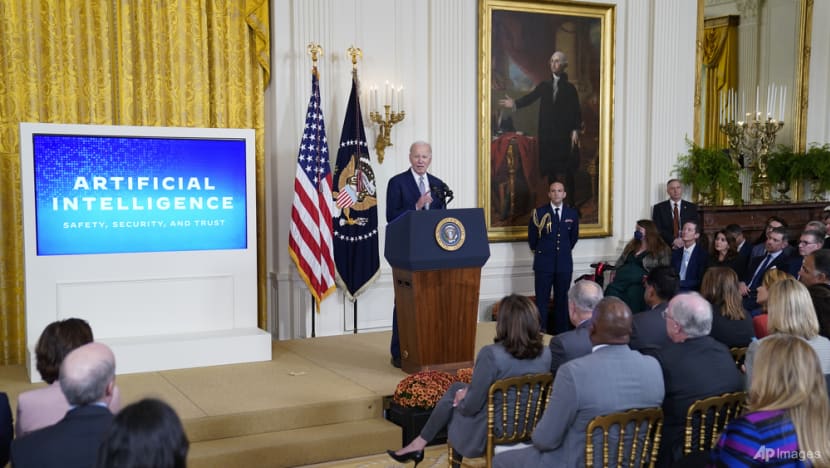Risks of AI use in the spotlight, even as US sets out guidelines in harnessing its full potential
The setting of guidelines on the use of artificial intelligence (AI) is gaining pace in the US, with President Joe Biden issuing a new executive order, and New York City becoming the first major city to unveil an AI action plan.


This audio is generated by an AI tool.
NEW YORK: As the use of artificial intelligence (AI) gains pace at various levels of the United States government, guidelines and safeguards are being introduced to harness the benefits while tackling the risks involved.
On Monday (Oct 30), US President Joe Biden issued a new executive order on AI.
“The Executive Order establishes new standards for AI safety and security, protects Americans’ privacy, advances equity and civil rights, stands up for consumers and workers, promotes innovation and competition, advances American leadership around the world, and more,” the White House said in a statement.
New York City had last month month unveiled a new action plan emphasising the responsible use of innovative AI technology, in what Mayor Eric Adams called “the first-of-its-kind for a major US city”.
However, Mr Adams is drawing criticism for his own use of AI, with campaign groups concerned about how it can be used to mislead would-be voters or spread misinformation.
COMMITMENT TO RESPONSIBLE AI USE
In an introductory note in the 51-page New York City AI Action Plan launched on Oct 16, Mr Adams called AI “one of the most impactful technological advances of our time”.
Harnessing AI could help improve services and processes across government, but comes with some associated risks, he said.
Through the action plan, “we are cementing our commitment to this emerging technology’s responsible use, and ensuring we are deploying the right tools in the right ways”, said Mr Adams.

The document was produced by the Office of Technology and Innovation, with input from 18 government agencies and insights from industry, academia and civil society.
Mr Adams said it is part of the city’s ongoing efforts to “approach technology in a smart way and use it to deliver better services and opportunities”.
Past efforts have included launching the nation’s largest free municipal broadband programme and expanding wireless infrastructure across historically underserved communities.
AI DRIVING MULTILINGUAL CAPABILITIES
Multilingual robots are now entering the mainstream market.
Mr Marty Abrams, CEO of American toy maker Mego, told CNA that the company’s 2XL talking robot can speak 35 different languages, and be used as a search engine just like Google.
Unlike other electronic toys with closed systems, such as the popular Furby doll, 2XL runs on an open system that is connected directly to a chatbot with AI capabilities.
“So you could ask it any question whatsoever and unlike any other product that’s out there, it doesn’t just give you back an answer, but it gives you back an answer through conversation. It remembers what you’ve said and understands and learns from your personality,” said Mr Abrams.

2XL’s creators said it uses responsible AI software to keep children safe from the dangers of the internet.
However, multilingual bots have got New York officials into trouble, with Mayor Adams himself on the receiving end of criticism, after using the technology to robocall residents to promote hiring halls and events in languages he does not actually speak.
“People stop me on the street all the time and say ‘I didn’t know you speak Mandarin’,” he said at a recent press conference. “We are using different languages to speak directly to the diversity of New Yorkers.”
MISLEADING USE OF AI
Mr Adam’s strategy has, however, been slammed by campaign groups, who accuse him of misleading the public.
Ms Sarah Roth, advocacy and communications associate at the Surveillance Technology Oversight Project, told CNA: “We see this as a US$32,000 PR (public relations) stunt, not only to convince New Yorkers that Mayor Adams is multilingual, but also to give an image of responsible use of AI, which we don’t see New York as actually doing.”
Concerns have also arisen over the expansion of facial recognition and gun detection technology by law enforcement in the city.
“We see these technologies as being very inaccurate and racist as well. There are several class action lawsuits being charged against police departments across the nation because facial recognition technology has falsely identified people as suspects,” said Ms Roth.
However, officials argue that such technology ultimately improves the lives of New Yorkers.
One initiative under the New York City AI Action Plan, for instance, is the launching of an AI-powered chatbot to provide residents with information and resources about how to set up and run businesses in the city.
Among other things, the plan aims to set up an AI steering committee and guidelines for the city, as well as develop a process for AI risk assessment and project review.
Mayor Adams has stressed the importance of recognising the potential risks of AI usage, such as inaccuracies or data privacy breaches.
Such risks are what regulators will have to increasingly monitor, as AI gets even more intelligent moving forward, said observers.














